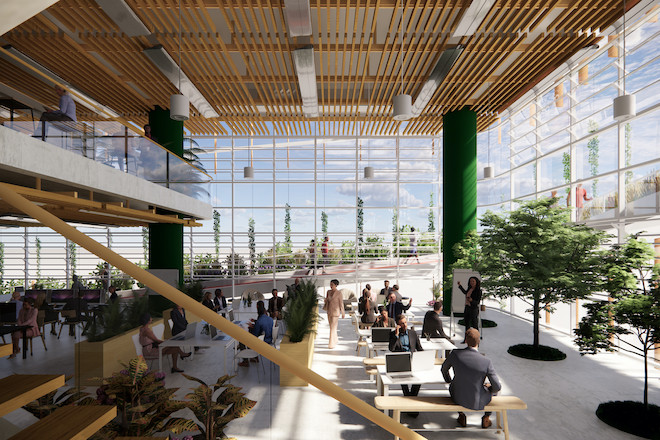
This article is published in collaboration with Arup.
The good news is that the world is waking up to the urgent need to take carbon out of the global built environment. Net-zero targets have been announced by hundreds of private and public sector organizations across the property, construction, and building design sectors.
Net-zero targets set by the property sector are welcome and essential, given that buildings and the wider built environment contribute more than a third of the total greenhouse gas emissions emitted continuously into the Earth’s atmosphere. These emissions are destabilizing the global climate system and threatening the safety of our daily lives—and those of future generations.
But targets are just the beginning. The real work comes in designing, constructing, and operating new and existing buildings in ways that do not generate emissions at anything like the scale we do so today. Whole life carbon is the primary metric the global property sector and its supply chains need to scale net-zero buildings.
We need breakthrough action
We know and accept there is no time to lose. Rapid reduction must be achieved in the volume of greenhouse gas emissions that humans emit into the Earth’s atmosphere. If we acknowledge the enormity of the emissions generated by the global property, construction and building design sectors, we need to recognize that maintaining the status quo will not allow us to achieve our net-zero targets. The time for action is now.
The global property sector must achieve two things by 2030, according to the United Nations’ High Level Climate Champions. The UN has identified two breakthrough goals for the global built environment to be achieved by 2030. They are:
- All new and refurbished buildings must be net zero in operation
- All new and refurbished buildings must achieve at least a 40% reduction in embodied carbon.
These goals for 2030 are daunting, but they are tangible. Fundamentally, they have been designed to keep us and our world safe from catastrophic climate change. By taking action now, we will begin to see total emissions generated by the global built environment coming down.
Moving beyond exemplar buildings
Today, there is a tiny number of genuinely net-zero buildings being designed, built, and operated anywhere in the world. These individual buildings are exemplars, not the norm.
One of the barriers to scaling net-zero buildings is the absence of an agreed standard for what is a net-zero building, leaving the property sector vulnerable to greenwash. The other primary barrier is a profound absence of data that can be used to guide decisions about how to strip carbon emissions out of buildings by using less and lower carbon materials, innovative construction techniques, and better building operations.
How then to scale the decarbonization of buildings and to do so quickly? This is where whole life carbon data becomes essential, and it is why Arup committed in 2021 to begin to assess our global building design project portfolio using whole life carbon techniques.
Adopting whole life carbon as a technique clarifies what is meant by “net-zero building”—it means the emissions generated by the whole building across its whole lifespan. Whole life carbon also drives the collection and analysis of data that every actor in the value chain will need to scale delivery of buildings with low embodied carbon and low operational emissions.
Zero: where, when, and how much carbon
Innovation is often born out of necessity. Our commitment to collect and analyze whole life carbon data about Arup’s global building design project portfolio has driven us to create a technology platform to collect the data that will begin to tell us what we all need to know:
- Where in a building, precisely, are emissions generated?
- When in a building’s full lifespan are emissions created?
- What are the emission quantities generated by each system within a building?
We have learned a great deal from the whole life carbon data we have collected and analyzed thus far, yet we know we have just begun. One of our most important insights has been gaining a clearer understanding of the scale of carbon emissions associated with our building design work. We refer to these emissions as our carbon handprint. These emissions are not part of our organizational carbon footprint, as they are not related to the daily operation of our business. Instead, these emissions are what result from our building design work for clients. They relate to how the application of expertise can generate emissions.
Unsurprisingly, the scale of emissions generated through our building design work for clients across the globe—our carbon handprint—is far larger than our organizational carbon footprint. Developing the capability to measure the emissions that are generated from Arup’s building design work for clients is important, even if it is a sobering experience.
Carbon benchmarks will drive us forward
Less than a year into collecting and analyzing whole life carbon data, we see the power of this approach to drive the global property sector and its supply chains toward more rapid decarbonization.
Whether you are a property investor, an architect, or the leader of a construction firm, what you need to achieve net-zero targets is carbon benchmarks. Which building in a development portfolio is on track to become a low carbon emissions exemplar building aligned with the UN Breakthrough Goals for the Built Environment? Which projects are off track? Which design choice will deliver the greatest carbon savings as part of a refurbishment? When we are targeting a 40% reduction in embodied carbon for a new building, what is the baseline we start from? How can value engineering objectives preserve emission reductions? We need industry-wide open and comparable whole life carbon datasets to allow us to answer these questions and so many more.
With good quality data, it will be possible to set accurate benchmarks to guide all actors across the industry about how to cut carbon quickly, deeply, and in ways that will last.
Hunting for embodied carbon
Until recently, the focus of the built environment sector has been on measuring and reducing operational carbon. These are the emissions generated when a building is in use, whether carbon is created by people managing the building or those who are occupying it. Driving down operational carbon will always be an essential element of the net-zero buildings challenge, but increasingly the focus is turning to embodied carbon. These are the emissions generated as part of the manufacture of materials used in buildings as well as emissions created during the transportation of materials and the construction and demolition of buildings.
Pinpointing the source and scale of embodied carbon in buildings allows us to see where carbon efficiencies are most needed. Already it is clear that the design of some building materials and systems have begun to be decarbonized, while the carbon emissions associated with others may have been underestimated. Whole life carbon data shines a light on the relative scale of embodied carbon across all building sub-systems and gives manufacturers, designers, and construction firms new insights to accelerate decarbonization.
Destabilization of the global climate system is the most profound and lasting risk the world faces. No one sector can achieve the carbon emission reductions needed to prevent catastrophic climate change. But the global property, construction and building design sectors have the power to make one of the largest contributions to climate action. Establishing large, open and comparable whole life carbon datasets is an essential step on the net-zero buildings journey.
This article was first published by Arup on 8 November 2022.
 Nigel Tonks
Nigel Tonks
Director, Arup
Nigel Tonks is a director, region board member, and the sustainable development lead for the UK, India, Middle East, and Africa at Arup. Having previously led the buildings sector in London, Nigel has over 30 years’ experience as a mechanical engineer, working with clients and collaborators to design and deliver passive low energy new and renovated buildings.
Working in several different countries, Nigel has experienced a wide range of regulation, green building standards and regional approaches to grappling with sustainable development. 

